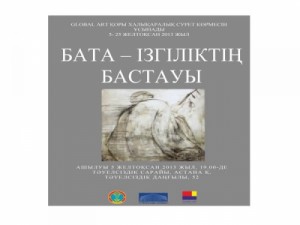 ASTANA – The international art exhibition, “Bata – For Tomorrow Without Losing Your Roots,” showcasing the work of famous Kazakh and international artists as well as students, opened on Dec. 5 in the Palace of Independence. The exhibition, curated by Marzhan Abildina, displays a variety of painting, sculpture, pottery and weaving.
ASTANA – The international art exhibition, “Bata – For Tomorrow Without Losing Your Roots,” showcasing the work of famous Kazakh and international artists as well as students, opened on Dec. 5 in the Palace of Independence. The exhibition, curated by Marzhan Abildina, displays a variety of painting, sculpture, pottery and weaving.
The exhibition is an exploration of bata, a Kazakh form of blessing. “Bata is the link between the past, present, and future of the Kazakh people,” said a statement issued about the event’s opening. “Through the exhibition, artists let the public judge what is the place of bata and one’s roots in modern life in the multi-ethnic country and in particular in the fast-growing capital of Kazakhstan, Astana.”
The artwork displayed was chosen to create a direct emotional connection between artist and viewer and contribute to the discussion about the place of Kazakh cultural codes in modern Kazakhstan.
“Bata is a blessing,” said Abildina at the press conference that preceded the opening. “In the Kazakh nation, it means a blessing from an elder person to a younger person. It is very important for us to keep this.”
Other artists echoed this, explaining the meaning and offering their own blessing. “I’d like to say that artists don’t talk much. We paint, that’s what we are, that’s what we’re here for,” said painter Saule Suleimenova. “Here, the meaning of this exhibition is to ask for a blessing for you all for the arts.”
International artists taking part in the exhibition spoke about the importance of art and art education. French artist Martine Rivasi-Offant and British educator and photographer Gareth Stamp both mentioned the need for more gallery space and more support for the arts and art education in Kazakhstan.
“Art and education go together,” said Rivasi-Offant, who has three paintings on display in the exhibition. “Art is one of the tools for opening students, artists and people to universality. Art is a miracle, a unique language to work peace and harmony between people in this violent world. … It’s really important to exhibit artists, because this language opens the mind.”
“Kazakhstan, I believe, is undergoing a Renaissance in its art and design,” said Stamp, whose portraits are part of the exhibition. “Traditional arts and crafts blending with modern ideas and technologies are giving a really exciting buzz to the arts scene in Kazakhstan. As this grows, so too must the provision for arts in Kazakhstan, both in education and in exhibition.”
Stamp also suggested that Astana should have a museum of modern design, and said he has started working with sponsors and other interested parties to make that idea a reality.
Speaking about her paintings, Rivasi-Offant said she was fascinated by the neutral landscape presented by the steppe. “It’s very interesting for a painter, because feeling and imagination can be projected onto this landscape, because there is no anecdote, no topic. … The work of a painter is to project his own feeling on the landscape.” She has found in the Kazakh landscape not picturesque things, she said, but a landscape in which feelings can be shown powerfully.
Astrid Banjav of Germany, who displayed works of pottery, has lived in Kazakhstan for one and a half years and was also inspired by the country’s landscape. “One [piece] is inspired by winter – Kazakhstan in winter is white, like a snowball with some dark dots, because you still have some places where there isn’t much snow.” Kazakh motifs and the passage of time also influenced her work, she said. In the press conference before the opening, Banjav said that she works with clay because, as it comes directly out of the ground, it keeps her rooted. “I think, when working with clay, it is very easy to do what bata is expecting, that you keep to your roots, because you are working with a material that nature gives you,” she said.
British Ambassador to Kazakhstan Carolyn Browne, among others, spoke at the opening event, which also included traditional music and dance performances.
The exhibition is the first major art event organised by the Global Art Fund.
Artists participating in the exhibition include Khassen Abayev, Saule Suleimenova, Bakhytnur Burdesbekov, Gulmira Telgoziyeva, Tokhtar Yermekov, Zamzegul Oralbayeva, Zhenis Kakenuly, Aktoty Kolke, Valeriy Pirozhkov, Dinara Nuger, Stanislav Bachin, Yessengali Sadyrbayev, Murat Sydykov, Kaliolla and Raikul Akhmetzhan, Faniya Isslamova, Serik Yermekov, Raushan Aspandiyarova and Khadzhimurat Boshtayev of Kazakhstan, Rivasi-Offant of France, Stamp of the U.K and Banjav of Germany.


